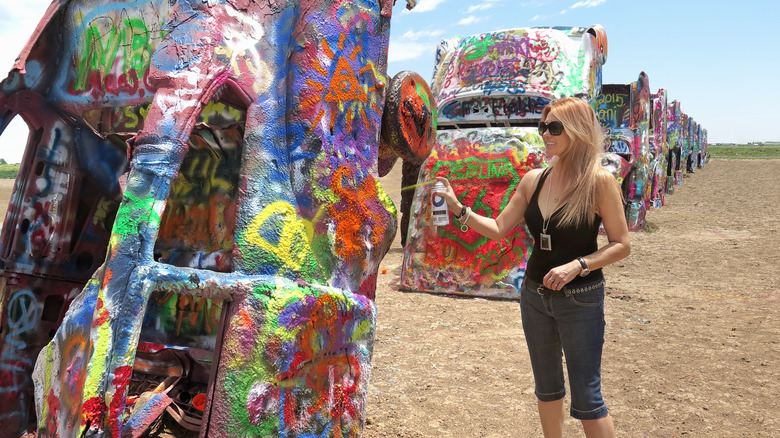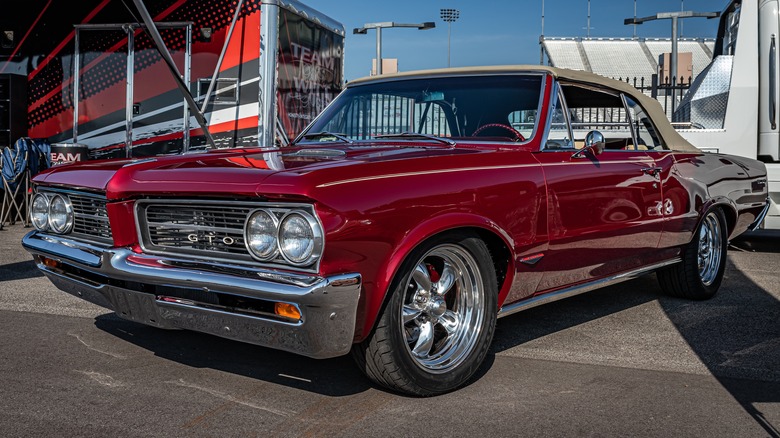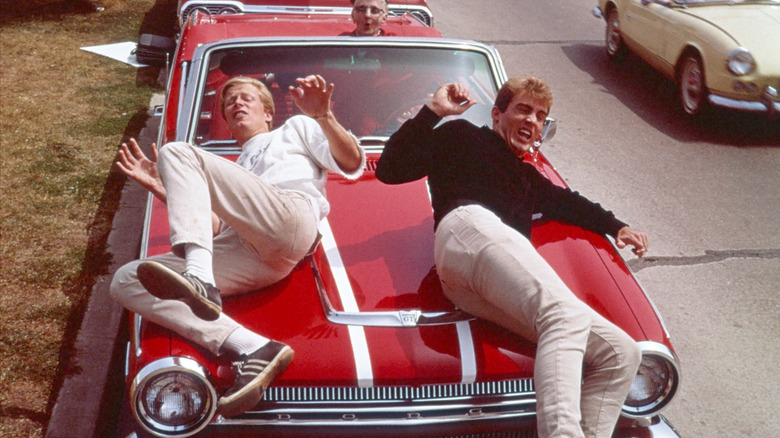Cars have been immortalized in popular culture since the American automotive and music industries had their coincidental heydays in the mid-20th century. The peak of the muscle car era intersected with the explosion of rock-n-roll in the United States, spanning the period from the 1950s through the 1970s. The nexus of the car song craze is likely The Beach Boys’ 1963 album «Little Deuce Coupe,» which is packed with car-themed songs. The title track peaked at No. 15 on the Billboard charts, but the album rose as high as No. 4 and spent 46 weeks in the top 200.
Advertisement
The Beach Boys were far from the only musical act to embrace car culture. John Prine, Bruce Springsteen, Janis Joplin, and Tracy Chapman all recorded well-known songs about cars. We could probably dedicate a month’s worth of stories to our favorite car-themed songs, but we worked to pare that catalog down to a lucky seven of our favorites.
Fun Fun Fun is our favorite Beach Boys car song
Just a few months after «Little Deuce Coupe» hit record stores, the Beach Boys were back in the studio to record their next album, «Shut Down Vol. 2.» The first track they laid down for this album was «Fun Fun Fun,» an upbeat ditty about a girl who tears up the streets in her father’s Ford Thunderbird until he learns of her escapades and confiscates her set of keys. The first-generation Thunderbird holds a special place in American car history for its stunning design, and Ford even tried to give the eleventh-generation T-Bird a retro look.
Advertisement
«Fun Fun Fun» has outlived the Thunderbird, remaining in the Beach Boys’ live sets through this past summer. It’s almost impossible to hear the song without tapping your foot or singing along to the chorus of «she’ll have fun fun fun ‘till her daddy takes the T-bird away.» The ditty also contains classic lines like «She makes the Indy 500 look like a Roman chariot race, now» and paints a vivid picture of 1960s cruising culture with mentions of hamburger stands and street racing. Although the song is explicitly about a Thunderbird, the album cover shows the band members leaning on a Chevy Corvette and what appears to be a Pontiac GTO.
Mercedes Benz by Janis Jopliin has an amazing origin story
One night in August 1970, Janis Joplin sat at Vahsen’s bar in Port Chester, New York with folk music icon Bob Neuwirth and actors Geraldine Page and Rip Torn. Joplin and Neuwirth riffed on a line written by Beat poet Michael McLure. McLure had been fiddling with an autoharp that Bob Dylan had given him and brainstormed the line, «C’mon God, and buy me a Mercedes-Benz.» Joplin and Neuwirth massaged that line into the song «Mercedes Benz,» which Neuwirth frantically scribbled on bar napkins. Joplin surprised her band by singing the song a cappella about an hour later at the Capitol Theater across town. (It’s worth pointing out that the song title does not have a hyphen, but the Mercedes-Benz brand does.)
Advertisement
She recorded «Mercedes Benz» at the tail end of her sessions for the album «Pearl» that Fall, and died three days later. According to Neuwirth, had Joplin survived through the remainder of the recording sessions, the song might not have made the album. As reported by Ultimate Classic Rock, Neuwirth told Yahoo!, «You know, it’s one of those songs that was never meant to see the light of day. It was just a bar improvise on the back of Michael McClure’s thought.»
Unlike nearly every other song on this list, «Mercedes Benz» isn’t a tribute to car culture or any particular model. Rather, it is a sardonic critique of materialism, and includes the bar-appropriate stanza, «Prove that you love me, and buy the next round. Oh Lord, won’t you buy me a night on the town.»
Advertisement
Prince’s Little Red Corvette is another metaphorical car tune
Prince’s «Little Red Corvette» has even less to do with the model named in the title than «Mercedes Benz,» although the song’s origins are equally fascinating. Lisa Coleman, keyboard player for Prince’s band The Revolution, told the BBC in 2019 how the song came to life in the back seat of her pink and white 1964 Mercury Montclair.
Advertisement
«He was ‘sleeping’ with someone we knew called Denise Matthews [aka Vanity] and she was ‘sleeping’ in the back of the car, too,» Coleman explained. «So I imagine they were making out, or doing whatever, in the back seat, and they probably had a wonderful moment of afterglow, which is when he got the seed of the idea… But it’s not a red Corvette, it’s a pink Mercury!»
The track first appeared on the 1982 album «1999,» and has since been included on eight anthology and greatest hits releases. When you parse the lyrics carefully, it becomes clear that the song is not about a car at all, although cars have always been tightly bound to the song’s root themes of virility and sexuality.
«I felt a little ill when I saw all the pictures of the jockeys that were there before me,» Prince sings. «Believe it or not, I started to worry. I wondered if I had enough class.»
Advertisement
Cadillac Ranch is a Bruce Springsteen classic

George Shelley Productions/Getty Images
Many of Bruce Springsteen’s songs celebrate the freedom and possibilities a car represents, like «Thunder Road,» «Drive All Night,» and «Racing in the Street.» His 1980 double album «The River» featured several songs with automotive themes, including «Ramrod,» Stolen Car,» «Wreck on the Highway,» and «Drive All Night.» The most rip-roaring track on the album is «Cadillac Ranch,» an ode to cars in popular culture. The song mentions «Eldorado fins, whitewalls and skirts,» the 1949 Mercury driven by James Dean in «Rebel Without a Cause,» and Burt Reynolds and his black Trans Am from «Smokey and the Bandit.» The Cadillac Ranch is an art installation outside Amarillo, Texas that features ten Cadillacs buried nose-first in the desert.
Advertisement
It was commissioned in 1974 by Stanley Marsh 3, who used the Arabic number instead of the Roman numeral III in his name because he felt the latter usage was pretentious. In 2014, Marsh told the New York Times that the Cadillac Ranch was «a monument to the American dream.» He added that to a young man who came of age in the 1950s, cars represented money, sex, and «getting away from home. And I assure you those were the three things that were on our minds when we were 16.» The Cadillac Ranch was moved further from the sprawling city in 1997, and over time the cars have been repainted and covered with graffiti, a development Marsh embraced.
The Pontiac GTO quickly inspired a tribute song

Gestalt Imagery/Shutterstock
The John DeLorean-designed Pontiac GTO debuted in 1964 and helped jump-start the muscle car era. Before the year was out, John «Bucky» Wilkin, who went by the stage name Ronny Dayton, wrote the song «G.T.O.» The tune is often mislabeled as «Little GTO» because of the first line, «Little GTO, you’re really looking fine.» It was the first single released by his band Ronny and the Daytonas, and reached No. 4 on Billboard’s Pop Singles chart en route to selling a million copies. Ronny and the Daytonas had modest success over the next few years, but broke up in 1969. The car Wilkin wrote about was a souped-up «tri-power» version, with three two-barrel carburetors atop the 389 cubic inch V8, a hot cam, and performance exhaust.
Advertisement
Bucky Wilkin’s songwriting career never matched up to that of his mother Marijohn, who earned places in the Nashville Songwriters Hall of Fame and Country Music Hall of Fame by penning the songs «Long Black Veil,» «One Day at a Time,» and «Waterloo.» Marijohn formed a publishing company called Buckhorn Music to publish her son’s song in 1964, and the next year she brought Kris Kristofferson on as a writer. After she died from heart disease in 2006, Kristofferson told the Nashville Songwriter’s Foundation, «She was a tough, intelligent and funny woman making it in a man’s world.»
Johnny Cash’s One Piece at a Time tells of a creative bit of larceny
Johnny Cash embraced the «Outlaw Country» label, recording songs about murder and drugs and performing at Folsom and San Quentin State Prisons in California. In 1976, Cash recorded «One Piece at a Time,» a novelty song written for him by Nashville Songwriters Hall of Famer Wayne Kemp. In the song, Cash goes to work on a Cadillac assembly line, and sneaks mismatched car parts out in his lunchbox and friend’s RV. His plan doesn’t quite go as he hoped, though — he ends up with a hodgepodge of parts from different years and models. He ends up with three headlights, one tailfin, and a title that weighs 60 pounds. As the song fades out, he lists every year from 1949 to 1970, and identifies the model as only an «automobile.»
Advertisement
That didn’t stop two men from recreating the FrankenCadillac. The first was Nashville salvage yard owner Bruce Fitzpatrick, who was solicited for the task by the record’s promoters. The car he assembled was used for a promotional tour, and destroyed soon afterward. The next intrepid soul to take on this project was Oklahoman Bill Patch, who put one together to raise money for his local Lion’s Club. Cash was so impressed with his work that he traveled to Welch’s hometown to perform a series of concerts, and the car is now on display at the Storyteller’s Hideaway Farm and Museum in Lyles, Tennessee.
Deadman’s Curve presaged tragedy for Jan Berry

Michael Ochs Archives/Getty Images
There is no shortage of tragic car songs, like Mark Dinning’s dirge-like «Teen Angel» and the Beach Boys’ equally funereal «A Young Man is Gone,» about James Dean’s fatal crash. If there is such a thing as an upbeat song about a deadly car accident, Jan and Dean’s «Deadman’s Curve» would qualify. The song was a 1964 collaboration between the duo’s Jan Berry, Beach Boy Brian Wilson, radio DJ Roger Christian, and Artie Kornfeld, who would go on to organize the legendary Woodstock festival. The catchy ballad tells the tale of a fatal drag race between the narrator in his Corvette and a challenger in a Jaguar.
Advertisement
The race starts at a red light on Sunset Boulevard and ends when the Jaguar’s driver is killed in a wreck at the titular bend in the road. «Deadman’s Curve» reached No. 8 on the Billboard Hot 100, but proved to be sadly prophetic for Berry. On April 12, 1966, he crashed his Corvette into a parked truck near the curve, and the resulting head injury left him with brain damage that lingered until his death in 2004. Berry was able to perform again about a year after his accident, but he and former performing partner Dean Torrence had a falling out and didn’t share the stage again until the late 1980s.